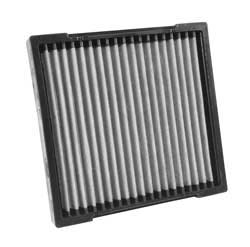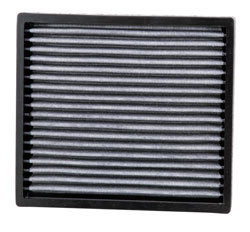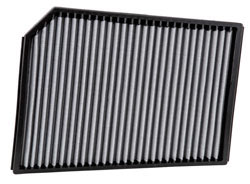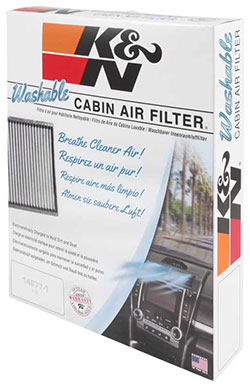Car Cabin Air Filters: Why We Need to Filter the Air Inside Our Passenger Vehicles
- 28 jul 2016
Google "air pollution" and several sites inform us that the leading cause of air pollution in the United States is motor vehicles, which release gaseous and microscopic particles as the engines run. That when we are out on the road we're at ground zero for inhaling harmful air should be obvious, but we don't even think about it. But the air is everywhere. When we step out of the car, we're back in it. Why the paranoia? Because in spite of awareness programs, state, national and international regulations and efforts by industries worldwide, air quality is still an issue. The effects of inhaling vehicular, industrial, and residential contaminants are a silent pandemic of asthma, stroke, heart and lung disease, and premature births. If we have a/c in home, office, public buildings, we have cleaner, filtered air. Now car makers equip our new vehicles with automotive a/c, or cabin, air filters. Every little bit helps everyone, not only asthma and allergy sufferers, and the very young and the elderly. Cabin air filters also help keep our car's ventilation and air conditioning system working properly by providing a clean, unrestricted flow of air.
Does your car have a cabin filter? More than 80 percent of new cars built today will have an air conditioning filter. Your owner's manual will tell you if your car has one. Lacking a manual, you can visit the manufacturer's website, or ask your dealer or mechanic if your car has a cabin air filter. Car cabin air filter location will vary by vehicle year, make, and model but is generally installed in one of three places. Most often a cabin filter can be found behind the glove box, as in the 2007-2016 Hyundai Elantra. It can be under the hood near the windshield, as in the 2000-2013 Chevy Impala, or underneath the dashboard as in the 2010-2012 Mazda3. As with your home vacuum cleaner, the filters need to be emptied after use and periodically replaced. Most cabin air filters can be replaced without special equipment, but some require basic hand tools to open the cabin air filter compartment. Discarding and installing a new cabin filter is easy, but they just choke the landfills. In 2014, K&N came up with a thrifty approach to this routine maintenance procedure by inventing a washable, reusable replacement car cabin air filter. Examples are the K&N VF2033 for 2009-2016 Honda Insight, Fit, CR-Z, and HR-V, and the K&N VF3008 for the 2000-2005 Jaguar S-Type, Lincoln LS, and Thunderbird. So what can we learn about cabin filters? What are cabin and a/c filters, and what do they do? Air pollution became a focus of an international environmental movement in the 1960s, and car cabin air filters were first developed in the late 1980s in Europe and Japan, out of concern for protecting sensitive drivers and passengers from inhaling pollen and dust. This concern quickly expanded to the need for protecting us all against air contaminated with diesel soot and gaseous substances in metropolitan areas with lots of car traffic (plus unburnt industrial smogs) that release hydrocarbons, sulphur dioxide, nitrous oxides, hydrogen sulfide, ammonia, and benzene, to name just the headliners of the pollutant short list. International Organization for Standardization (ISO) testing and manufacturing standards were drafted in 1994 and updated in 2001 for particulate and odor-reducing functions of cabin filters. K&N's a/c filters trap particles and help to reduce odors inside the cabin. Examples are the K&N VF2027 for the 2011-2016 Dodge Charger, Challenger, and Chrysler 300, and the VF2000 for the 2005-2016 Toyota Avalon, Prius and Scion. Manufacturer's stock cabin air filters are usually folded paper or some combination of paper and fibers. They are often rectangular or nearly square in shape and are simply a physical barrier to trap dust, pollen, leaves and other debris, reducing the flow of chemically contaminated air that makes it into the ventilation and air conditioning system. The particles accumulate on the surface of the filter and eventually cake up, forming their own layer, restricting the flow of incoming air. To keep the air clean in the cabin, these filters are intended to be discarded at least annually. K&N car cabin air filters are a fan-folded, single layer of thermally bonded nonwoven synthetic material held in a molded urethane frame with wire screening. The filter material itself has been electrostatically charged to attract and hold dirt. As air flows through the K&N cabin air filter, dirt, and allergen particles become trapped in the synthetic fibers, and the electrostatic charge helps hold them in place. This design allows for increased airflow, even as the filter gets dirty. The construction of the K&N cabin filter is intended to allow it to be removed, washed, recharged, and reused. Watch the K&N washable cabin air filters overview video for an excellent introduction to cabin air filters and what they do.
Why do car cabin filters need maintenance? There is truth to the old saying, "If it ain't broke, don't fix it.", but following a preventive routine keeps a/c parts from wearing or breaking, and keeps the car on the road longer. Furthermore, as the saying goes, "an ounce of prevention is worth a pound of cure," which is another truism that applies as much to vehicle health and safety as to personal wellness. Just as you change the oil and refresh the fluids in the engine, the rest of the car's systems need regular check-ups and cleanings. A clogged car cabin air filter can, besides creating an uncomfortable environment for occupants by no longer trapping dust, fungus, spores and bacteria, also allow moldy odors and mildew to invade the cabin. The cumulative effects also put a strain on the heating and air conditioning systems. This is a great reason to perhaps coordinate cabin filter changes with your annual or semi-annual A/C service. Your dealer or mechanic can do this for you, or you can do it yourself. Removing, discarding, and replacing the OEM cabin filter with the same stock version is easy. But so is investing in a K&N car cabin air filter that is washable, reusable, and guaranteed with a 10-Year/Million Mile Limited Warranty. Cleaning your K&N washable cabin air filter works best if you use the 99-6000 K&N refresher kit and follow these simple steps:
The keys to a successful service are thoroughly rinsing the cabin filter, letting it dry completely and using K&N's refresher spray. The spray brings back the electrostatic charge so the filter can continue to help capture many types of dust, mold, mildew, spores, fungus, bacteria, and germs while helping to control odors. K&N has a washable, reusable car cabin air filter for your car When you're ready to try a K&N cabin filter in your car, visit the K&N website and use the Search by Vehicle tool and you can find a local K&N retailer by plugging your location into the K&N Dealer Search as well. K&N is developing new cabin air filters all the time and if they do not currently offer a filter for your vehicle, you can personally request that K&N makes one using the online product request. K&N car cabin air filters are designed to last for years of use and are guaranteed by the K&N 10-Year/Million Mile Limited Warranty. It's a win-win-win scenario, for owners, for the vehicles, and the environment. |
|||
|
|||



















